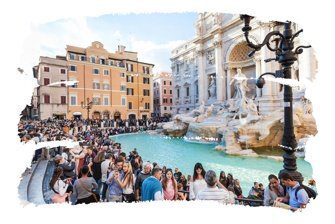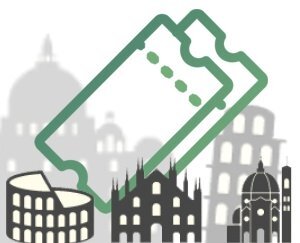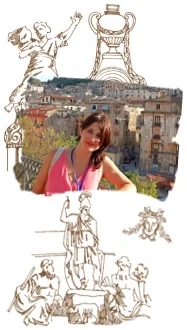How to visit the Tomb of Saint Peter and the Vatican Necropolis?
Visiting the Tomb of Saint Peter is the dream of many, but there are those who do not know that it is possible to visit this place full of good energy. Another thing that not everyone knows is that there is a tour in the underground of the Vatican, where it is possible to visit several catacombs. Well, let’s go in parts, shall we? We will give you enough information to know how to visit the tomb of Saint Peter and the Vatican Necropolis. Here at Your Travel to Italy with Ana Patricia you make the trip of your dreams!!! ALSO: see our “Accommodation in Italy – Tips for your holidays!”
1) How to visit the tomb of Saint Peter and the Vatican Necropolis? TOMB OF SAINT PETER
How do I visit St. Peter’s tomb? Despite having almost ‘exclusive’ access (only 250 people enter there per day), it is not impossible to schedule a visit there, but you must book a LOT of time in advance. The visit lasts, more or less, an hour and a half and the groups to make the tour are small (maximum 12 people), in addition it is possible to request a guided tour in the desired language, but the request is not always granted. The date and time is up to them, that is, in the email inform the period of your visit and they will return with the available dates.
Useful information
The visit is made by an expert guide or by a member of the Church who lives in the Vatican, which makes it even more fun! The ticket costs 13 Euros per person and, to request it, there are two email addresses available: [email protected] or [email protected] – you can send a copy if you prefer. It is necessary to inform in the subject of the email “Scavi Tour” and in the message, inform:
- Exact number of participants (Numero esatto dei partecipanti.);
- Name of the participants (Nomidei partecipanti);
- Requested language (Linguarichiesta during the visit – Inglese);
- Period of days that you will have available while you are in Rome indicating the month with letters (Periododi giorni / always indicate il mese in lettere);
- How you prefer to receive the reply and include an email address. (Modalità di risposta).
- If you prefer, you can fill out a form directly on the Excavation Office page. For that, CLICK HERE!
Tips
- It is strictly FORBIDDEN to photograph inside both the tomb and the catacombs, the ‘code dress’ there is also very restricted: men, pants, and women, skirt or dress just below the knee, or pants; covered shoulders for both.
- Children under 16 CANNOT enter;
- The visit is not recommended for anyone who has a health problem that can get worse with humidity and heat or for those who suffer from claustrophobia.
- Be at the location indicated at least 15 minutes before the time confirmed by the office.
- There is a bag search at the entrance and large volumes, such as large bags and backpacks, are not allowed. In case you need to store something, there is a luggage storage on the right side of the Basilica facade.
- Access is through the side of the Church and it is necessary to present the reservation to security guards; tickets can be picked up in person at Ufficio Scavi (Excavation Office) – Via Paolo VI.
- The tour ends inside the Basilica, that is: ‘combine’ the tours and visit the Basilica afterwards. MORE ABOUT ROME!
2) How to visit the tomb of Saint Peter and the Vatican Necropolis? ITINERARY OF THE TOMB OF SAINT PETER
What to expect from the tour?
- First, they will tell you a little about the history of that place. The Obelisk, which is now in the center of the Square, and which was stolen from the Egyptians by orders from Caligula, used to be where there is now a white square, near the excavation office. It is said that the Obelisk was probably the last thing that Saint Peter saw before he died.
- Going down through the tight access, one last warning is given: if someone feels bad, let them know IMMEDIATELY, the tour is interrupted right away! There are 23 mausoleums down there and back there was a street.
- The floor is made of black and white mosaic and noble people of various religions were buried there. Remember that all that visible is probably just the ‘tip of the iceberg’, since there must be much more below our feet! Imagine that, long ago, it was possible to see the sky from there, breathe fresh air … It is really impressive to imagine what life was like there!
- A short walk leads to the tomb of Saint Peter. The people there take turns in a friendly and respectful way to see up close what the Church protects there: the bones of St. Peter. With a strategically placed light, the visit becomes exciting when we meet the remains of the so-called ‘best friend of Jesus’.
Persecution of Christians and the Death of Peter
The Vatican, at the time of the empire, was the place where the spectacles for the people took place, called the Circus: gladiatorial fights, deaths of the condemned and fights between animals and humans. It is said that when Nero set fire to Rome (legend or truth, we will never know!) the Catholics who were to blame, conclusion: Catholics were violently persecuted and killed: some were killed on the cross, others were eaten alive by animals, and so many were burned alive and some murdered by the army. Since Peter was known as the founder of the Catholic Church, of course he would not escape death.
Being considered unworthy of being crucified like Jesus, he was crucified upside down in the middle of that circus. His body was buried in a hill, and there it ended up becoming a kind of cemetery. That circus lost its grace and, thus, the Coliseum was born: bigger, more beautiful and imposing. With the construction of the Coliseum, the Circus lost its charm and, with the history of St. Peter being known, the former Circus became a place of pilgrimage, since when Constantine took over the empire, he abolished persecution of Christians.
Site Preservation
With the large number of people going to the tomb of Saint Peter, the place began to be preserved by his followers. Over the years, the church that had been built there was demolished and, by order of Pope Julius II, Saint Peter’s Basilica was built and, legend has it, that he wanted it to be EXACTLY on top of the tomb of the namesake Saint.
‘Forgotten’ in time, the Vatican tombs were rediscovered in the 20th century, when Pope Pius XII ordered a reform of the tombs of predecessor Popes. But, in order not to have his ‘little secret’ discovered by the Germans, the Pope who ordered the excavation said he was ‘renovating the gardens’! As predicted, well below the basilica, they found the tomb of Saint Peter.
A Big Surprise
Surprisingly, Peter’s mortal remains were not there! With a certain disagreement and a lot of determination, during the 50s, archaeologist Margherita Guarducci decided to investigate to find out where Pedro’s bones were and she found them: in a discreet hole that was in a red wall with the Greek inscription ‘Petrós Ení’ which means ‘Peter is here’!
The bones were wrapped in a noble fabric and the studies indicated that the bone was from the year 4 A.D., that is, everything indicated that the bones were really from Saint Peter. The Vatican soon announced the big news to the world, and questions soon began. The fact is that there are those who say it is a lie and there are those who believe without any doubt that the mortal remains are, in fact, from Saint Peter. There are also those who say that Peter was never in Rome, and probably his bones are not really ‘his’.
Visit other Catacombs in Rome!
Other interesting catacombs in Rome are as follows:
Catacomb of Saint Agnes
Catacomb of Saint Agnes: At 13 years old Agnes already had many suitors, because she was beautiful! Fulvius, a Roman who was in love with the girl, was the son of the mayor of Rome at the time and, being rejected, since Agnes only wanted to serve God, he denounced her as a Christian to his father. As there was persecution of Christians at that time, Inês was arrested and subjected to various punishments. After refusing to accept one of them, the mayor ordered her to be placed naked in the center of a brothel, she just did not have her divine protection: a strong light that dazzled the eyes of anyone who tried to look at her. Her hair grew magically and protected her body from nakedness.
Her first miracle was to heal a man who was blinded by the light she emanated when he tried to grab her; after that another man tried to rape her, but this time an angel of the Lord killed him. Agnes, again, felt sorry for the man and prayed to God: the man was resurrected. Today, in the place where that brothel was, there is the Basilica of Saint Agnes.
Catacomb of Saint Callistus
Catacomb of Saint Callistus: Son of a poor Roman family, Calixto was born in 160 and suffered harsh penalties. He was deported to Sardinia where, as a conviction, he had to face forced labor in the mines. He collaborated with Pope Victor and then, as a deacon, he helped Pope Zephyrinus. With the death of Pope Zephyrinus, the clergy and people elected Callistus to be his successor, even with his slave background. During the six years of zealous and holy shepherding, St. Callistus condemned the doctrine against the Most Holy Trinity and declared God his eternal Father.
Catacomb of Saint Domitilla
Catacomb of Saint Domitilla: Saint Flavia Domitilla was a noblewoman from ancient Rome and married to a consul named Flavius Clemens. She was the niece of one of the most famous Roman emperors, Vespasian, Domitian’s father. By the year 100, Flavia Domitilla was already married to Flavius Clemens and the couple were sympathizers with Christianity, which was prohibited at the time. Enchanted by the beauty of the Christian faith and the teachings of Jesus Christ, Flavia Domitilla took her faith before the Roman court: she was arrested, tried and, as she did not renounce the Christian faith, she was condemned to exile. They say that Flavius, her husband, was beheaded. Exiled on the island of Ponza, in the Tyrrhenian Sea, Flávia Domitila spent her last days in agony and experienced suffering and pain, yet her faith did not diminish and she kept her hope, surrendering her soul to God.
Catacomb of Saint Sebastian
Catacomb of Saint Sebastian: Saint Sebastian, like Saint George, was a Roman soldier. He was martyred for his faith and his history is known only from the Roman proceedings of his condemnation and martyrdom. He was born in the city of Narbonne, France, in A.D. 256 and his name, of Greek origin, Sebastós, means divine. He and his family moved to Milan and he joined the Roman army and took over as Captain. Always very dedicated to his career, he received recognition from the Roman emperor, Maximian, but the emperor did not know that Sebastian was a Christian. Sebastian, whenever possible, visited imprisoned Christians and took words of faith to the sick people.
When Maximian heard that there were Christians in his army, he ordered a ‘hunt’ for these Christians: they would be expelled from the army. Sebastian was denounced by a soldier and the emperor felt betrayed and ordered Sebastian to renounce his faith in Jesus Christ. Sebastian, of course, refused to renounce his faith and the emperor decided that he should be killed to set an example for others who refused to do the same.
His death before everyone
Not happy, Maximiano demanded that Sebastian’s death be before everyone, slow and cruel. He would be killed by arrows. The archers then left him naked, tied him to a pole in the Palatine Stadium and they shot their arrows at him: and so they left him, so that he would bleed to death. Sebastião was saved by Irene, a devout Christian, who noticed that he was still alive. Irene took him home and took care of his injuries.
After healing, he continued to evangelize and presented himself to Emperor Maximian, who did not respond to his request to stop persecuting Christians. Disconcerted, the emperor demanded that he be flogged and then thrown into a sewer. However, after he died, Saint Sebastian appeared to Lucina and told her where his body was: hanging from a well; there he asked that he be buried in the catacombs with the apostles. Many say that Sebastião was buried in the garden of Lucina’s house, on Appian Way, which today is where his Basilica is located. The Basilica of Saint Sebastian was then built in the catacombs. See the post for more details: What are the Catacombs of Rome worth visiting?
Are you going to stay in Rome? So you can get our exclusive hotel tips!
Here you will find great and free tips to not get fooled when choosing your hotel in Italy.
Plus: read our tips and advices about the Rome neighborhoods and where to stay! Here you will find the perfect hotel for you and for your needs, respecting you budget! Also: booking at booking.com, you will help us to keep our blog and for free! No fees, no click baits, no fake news!
Hotel I suggest near the Historic Center
If you are passionate about art and would like to stay in the center where you can move around walking, as well as having countless possibilities for places to have lunch / dinner or a snack, I advise you to stay in the historic center. Regions near the Trevi Fountain, the Coliseum, the Roman Forum, the Imperial Forum and the Villa Borghese, Piazza Spagna and Piazza Navona can be considered as “historic center”. These are the most expensive areas, but you will be close to everything, literally!
If you want to save a great option is the B&B, click on the links below and get to know each one. If you like the suggestion make your reservation and guarantee good prices.
If you prefer a good hotel, I have three options that I really like, click on the links below and get to know each one. If you like the suggestion make your reservation and guarantee good prices;)
Hotels that I suggest near the San Giovanni Region
For those who want to find cheaper alternatives in quiet areas, but at the same time close to the means of transport to the center, I suggest the region of San Giovanni or Monti (near the metro stations San Giovanni, Castro Pretorio and Circus Massimo) – which it is a more residential neighborhood; therefore, more economical and quiet! And with just 15 minutes by subway you will be in the center too!
I have two options for Hotels that I recommend, click on the links below and get to know each one. If you like the suggestion make your reservation and guarantee good prices;)
I have two options of B&B that I recommend, click on the links below and get to know each one. If you like the suggestion make your reservation and guarantee good prices;)
Hotels I suggest near Vatican City
An interesting area to stay and a little cheaper than the historic center is the Vatican area (Vatican Museums) which is very well connected with everything.
I have two options of B&B that I recommend, click on the links below and get to know each one. If you like the suggestion make your reservation and guarantee good prices;)
If you prefer a hotel, I have three options that I recommend, click on the links below and get to know each one. If you like the suggestion make your reservation and guarantee good prices;)
Hotel I suggest near Termini Station
For those who prefer to stay in neighborhoods that have good access to the rest of the city and at a better price, then you should choose accommodation in the surroundings of Termini Station (from where a dense network of public means of transport starts, serving both: the local people and tourists).
I have 3 good hotel suggestions in Termini, click on the links below and get to know each one. If you like the suggestion make your reservation and guarantee good prices;)
If you prefer B&B I have 2 good suggestions, click on the links below and get to know each one. If you like the suggestion make your reservation and guarantee good prices;)
Hotels that I suggest in Trastevere
For those who prefer to “taste” authentic and characteristic Rome, there is nothing better than booking a hotel in Trastevere (on the outskirts of the city’s historic river), full of typical Roman history and traditions, known for the tortuous streets of sampietrini stones and the centers medieval style housing.
The neighborhood is in the historic center and to the right of the Tevere River, in the midst of a spectacular landscape, where each visitor can observe the countless churches and squares (such as Santa Maria in Trastevere). In addition, this neighborhood offers several local restaurants and canteens for those who want to try typical Roman cuisine.
If you want to save a great option is the B&B, click on the links below and get to know each one. If you like the suggestion make your reservation and guarantee good prices;)
If you prefer a good hotel, I have two options that I really like, click on the links below and get to know each one. If you like the suggestion make your reservation and guarantee good prices;)
Conclusion
How to visit the tomb of Saint Peter and the Vatican Necropolis? Rome goes beyond what is visible to our eyes and its ‘cellars’ hide real pearls! If you feel insecure or have no time, and need help to organize your trip, do not hesitate to look for me! I will love to help you make your dream trip to Italy. And how can I do that? Continue reading this post until the end and you will understand how can we make your life and journey easier.
Did my post help you? If yes, make sure to leave your comment below, but if you still have questions, just leave them as a comment below and I will reply, O.K.?
An Extra Help for your Trip
The best content from Your Travel to Italy!
Learn more about our tours in Italy right now!
- What to visit in Italy in 10 days?
- The ten must-see places in Tuscany?
- The best tips to save on your trip to Italy?
- What are the 10 most visited cities in southern Italy?
- Airports in Italy? How to get to your hotel? (Venice, Milan, Rome, Florence)
- What to do in 1/2/3/4 days in the main Italian cities?
- The best tips on food in Italy (wines, typical food, enogastronomy tours)
- How to get from Fiumicino Airport to Rome downtown?
- Your Travel to Italy: 10 tips for traveling through Italy!
Best regards from Italy






 Save money!
Save money!